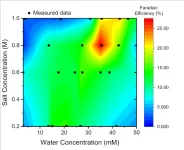(Press-News.org) New research has debunked the idea that there is an “obesity paradox”, whereby patients with heart failure who are overweight or obese are thought to be less likely to end up in hospital or die than people of normal weight.
The study, which is published in the European Heart Journal [1] today (Wednesday), shows that if doctors measure the ratio of waist to height of their patients, rather than looking at their body mass index (BMI), the supposed survival advantage for people with a BMI of 25kg/m2 or more disappears.
The “obesity paradox” relates to counter-intuitive findings suggesting that, although people are at greater risk of developing heart problems if they are overweight or obese, once a person has developed a heart condition, those with higher BMIs appeared to do better and were less likely to die than those of normal weight. Various explanations have been suggested, including the fact that once someone has developed heart problems, some extra fat is somehow protective against further health problems and death, especially as people who develop a severe and chronic illness often lose weight.
John McMurray, Professor of Medical Cardiology at the University of Glasgow (UK), who led the latest research, said: “It has been suggested that living with obesity is a good thing for patients with heart failure and reduced ejection fraction – which is when the main chamber of the heart is unable to squeeze out the normal amounts of blood. We knew this could not be correct and that obesity must be bad rather than good. We reckoned that part of the problem was that BMI was a weak indicator of how much fatty tissue a patient has.”
As Professor Stephan von Haehling, Consultant Cardiologist, and Dr Ryosuke Sato, a research fellow, both at the University of Göttingen Medical Center (Germany), write in an accompanying editorial [2], BMI fails to take account of the body’s composition of fat, muscle and bone, or where the fat is distributed. “Would it be feasible to assume that an American professional wrestler (more muscle) and a Japanese sumo wrestler (more fat) with the same BMI would have a similar risk of cardiovascular disease? The same is true for persons such as Arnold Schwarzenegger in his younger years when he starred as the ‘Terminator’ with a BMI of ~30 kg/m2.”
The study published today is the first to look at different ways of measuring the size and proportions of patients, including BMI, but also anthropometric measurements such as waist-to-height ratio, waist circumference and waist-to-hip ratio, and adjusting the patient outcomes to take account of other factors that play a role in, or predict, these outcomes, such as levels of natriuretic peptides – hormones that are secreted in the blood when the heart is under pressure, as with heart failure.
“Natriuretic peptides are the single most important prognostic variable in patients with heart failure. Normally, levels of natriuretic peptides rise in people with heart failure, but patients living with obesity have lower levels than those who are normal weight,” said Prof. McMurray.
Prof. McMurray and colleagues analysed data from 1832 women and 6567 men with heart failure and reduced ejection fraction who were enrolled in the PARADIGM-HF international randomised controlled trial taking place in 47 countries on six continents [3]. When the patients were randomised, doctors collected data on BMI, blood pressure, anthropometric measurements, results from blood tests, medical histories and treatments. The researchers were interested in which patients were hospitalised with heart failure or who died from it.
An “obesity-survival paradox” showed lower death rates for people with BMIs of 25 kg/m2 or more [4], but this was eliminated when the researchers adjusted the results to take account of all the factors that can affect outcomes, including levels of natriuretic peptides.
First author of the study, Dr Jawad Butt, a research fellow from Copenhagen University Hospital—Rigshospitalet, Copenhagen (Denmark), who carried out the analyses, said: ”The paradox was far less evident when we looked at waist-to-height ratios, and it disappeared after adjustment for prognostic variables. After adjustment, both BMI and waist-to-height ratio showed that more body fat was associated with a greater risk of death or hospitalisation for heart failure, but this was more evident for waist-to-height ratio. When looking at waist-to-height ratio, we found the top 20% of people with the most fat had a 39% increased risk of being hospitalised for heart failure compared to people in the bottom 20% who had the least fat.”
Prof. McMurray said: “Our study shows there is no ‘obesity survival paradox’ when we use better ways of measuring body fat. BMI does not take into account the location of fat in the body or its amount relative to muscle or the weight of the skeleton, which may differ according to sex, age and race. In heart failure specifically, retained fluid also contributes to body weight. It is indices that do not include weight, such as waist-to-height ratio, that have clarified the true relationship between body fat and patient outcomes in our study, showing that greater adiposity is actually associated with worse not better outcomes, including high rates of hospitalisation and worse health-related quality of life.
“Obesity is not good and is bad in patients with heart failure and reduced ejection fraction. These observations raise the question as to whether weight loss might improve outcomes, and we need trials to test this. In the UK, the National Institute for Health and Care Excellence, NICE, now recommends that waist-to-height ratio instead of BMI is used for the general population, and we should support this for patients with heart failure too.
“It is important because the underdiagnosis of heart failure in people living with obesity is a major issue in primary care. Patients’ symptoms of breathlessness are often dismissed as due solely to obesity. Obesity is a risk factor and driver of heart failure. Whereas in the past weight loss may have been a concern for patients with heart failure and reduced ejection fraction, today it is obesity.”
Prof. von Haehling and Dr Sato write in their editorial: “The present findings raise the alarm over the term ‘obesity paradox’, which has been claimed to be based on BMI. Can we tell obese HF [heart failure] patients just to stay as they are? To adequately address this question, not only should the obesity paradox be revisited even in patients with HF with preserved ejection fraction (HFpEF) and in lean HF patients by WHtR [waist-to-height ratio], which better reflects pathophysiological processes of obesity, but also further tests are warranted to validate the effect of weight loss in ‘truly’ obese HF patients with a high WHtR.”
Limitations of the study are that it can be more difficult to accurately measure body shapes, such as waist circumference, especially when the measurements are carried out by different people; there may be further unknown factors that could affect the results; the analysis was carried out on measurements and other data taken at the time participants joined the study and did not take account of any changes in weight or waist circumference during the follow-up period; there were no data on the cardiorespiratory fitness of the participants, which could have an effect on the link between anthropometric measurements and outcomes; and, finally, only 153 patients were underweight, with a BMI of less than 18.5 kg/m2, and 171 patients with a waist-to-height ratio of less than 0.4 (0.5 is considered a healthy ratio), so the study’s findings cannot be extrapolated to patients with low BMIs or waist-to-hip ratio.
(ends)
Notes:
[1] “Anthropometric measures and adverse outcomes in heart failure with reduced ejection fraction: revisiting the obesity paradox”, by Jaward H. Butt et al. European Heart Journal. doi:10.1093/eurheartj/ehad083
[2] “Revisiting the obesity paradox in heart failure: what is the best anthropometric index to gauge obesity?” by Ryosuke Sato and Stephan von Haehling. European Heart Journal. doi:10.1093/eurheartj/ehad079
[3] PARADIGM-HF (Prospective comparison of ARNI with ACEI to Determine Impact on Global Mortality and Morbidity in Heart Failure) was a randomised, double-blind, placebo-controlled trial in patients with chronic heart failure with reduced ejection fraction (HFrEF), evaluating the efficacy and safety of angiotensin receptor-neprilysin inhibitor saubitril/valsartan compared with enalaparil, added to standard care.
[4] The study used the World Health Organization BMI categories: <18.5 kg/m2 is underweight, 18.5-24.9 kg/m2 is normal weight, 25-29.9 kg/m2 is overweight, and 30 kg/m2 upwards is obese.
END
Study shows ‘obesity paradox’ does not exist: waist-to-height ratio is a better indicator of outcomes in patients with heart failure than BMI
2023-03-22
ELSE PRESS RELEASES FROM THIS DATE:
The devil is in the details: Re-imagining fertilizer precursor synthesis
2023-03-22
Osaka, Japan – The Haber–Bosch reaction helps feed the world by converting nitrogen into ammonia, a fertilizer precursor. However, its carbon footprint is huge: this one reaction is the source of nearly 2% of global carbon emissions. Now, in a study recently published in ACS Energy Letters, researchers from Osaka University have helped re-imagine this reaction to improve the sustainability of the chemical industry.
Replacing the Haber–Bosch reaction with a more sustainable alternative has been an active area of research for many years. These efforts have led to a globally well-established electrochemical reaction for ammonia ...
Unmasking the secret of broadly neutralising COVID-19 therapeutic antibodies
2023-03-22
The rapid evolution and emergence of new SARS-CoV-2 variants, such as the Omicron variant, renders it highly capable of evading the host immunity.
At the same time, vaccines based on original wild-type strain of SARS CoV-2 shows reduced protection against newer variants, particularly for the Omicron variant. This results in break-through infections among those vaccinated and highly infectious among non-vaccinated individuals.
Thus, it remains uncertain whether new emerging variants of the COVID-19 disease can escape the protective immune response ...
BetaLife and A*STAR Collaborate to develop next generation cell-based therapy for diabetes treatment
2023-03-22
Up-and-coming local biotech startup BetaLife Pte Ltd (“BetaLife”) is collaborating with the Agency for Science, Technology and Research (A*STAR) to accelerate the development of next generation cell-based therapy for diabetes. BetaLife, a stem cell therapy company focused on developing regenerative medicine for diabetes, has acquired the rights to human induced Pluripotent Stem Cell (iPSC) technology from A*STAR. This technology enables the generation of iPSCs, which are cells that have similar properties to embryonic ...
Endangered vulture returns to Bulgaria after being extinct for 36 years
2023-03-22
The Cinereous Vulture (Aegypius monachus) - also known as Black Vulture, Monk Vulture or Eurasian Black Vulture - is the largest bird of prey in Europe.
Globally classified as Near Threatened, its populations in southern Europe, once abundant, have been experiencing a dramatic decline since the late 1800s. So dramatic, in fact, that by the mid-1900s, these birds had already been nowhere to be seen throughout most of their distributional range across the Old Continent. In Bulgaria, the species has been considered locally extinct since 1985.
Thanks to the re-introduction initiative that was started in 2015 by three Bulgarian non-governmental organisations: ...
Nine in 10 women enter pregnancy with at least one indicator that risks baby’s health
2023-03-22
Nine in ten women in England enter pregnancy with at least one indicator that may increase health risks to them and their baby, according to new research.
Common indicators were women not quitting smoking, failing to take folic acid before pregnancy or having a previous pregnancy loss.
Researchers from the NIHR Southampton Biomedical Research Centre, hosted by University Hospital Southampton and University of Southampton, analysed data from over 650,000 mothers.
They created a first national picture of women’s health before ...
CABBI/GLBRC team explores leaf microbiome in perennial bioenergy crops
2023-03-21
"Have you ever wondered about life on a leaf?"
Great Lakes Bioenergy Research Center (GLBRC) researcher Ashley Shade asks a simple question, but it’s one well worth investigation. The aboveground part of plants where microbes reside, or the phyllosphere, represents the largest environmental surface area on the plant. Much of this area is grown as cultivated agriculture, and understanding the interactions between plants and the microorganisms that live on their surfaces may help us develop agricultural management practices that can increase crop productivity and resilience. In their newly published study, Department ...
Turn off porch light to aid caterpillars — and safeguard backyard ecosystems
2023-03-21
ITHACA, N.Y. – Moderate levels of artificial light at night – like the fixture illuminating your backyard – bring more caterpillar predators and reduce the chance that these lepidoptera larvae grow up to become moths and serve as food for larger prey.
This ecological impact was demonstrated in a new Cornell University study published in the Proceedings of the Royal Society B: Biological Sciences.
The scientists placed more than 550 lifelike caterpillar replicas made of soft clay in a forest, setting to ascertain how the mockups were attacked and hunted by predators compared to a control group.
“We measured predation ...
Anne Kornahrens, Hertz Foundation Director of Community, selected as delegate to International Younger Chemists Network Assembly
2023-03-21
The Fannie and John Hertz Foundation is proud to announce that Anne Kornahrens, Director of Community, has been selected as a 2023 U.S. delegate to the International Younger Chemists Network (IYCN) Assembly.
Kornahrens will attend the 52nd International Union of Pure and Applied Chemistry (IUPAC) General Assembly and World Chemistry Congress, to be held in The Hague, Netherlands, August 18–25, 2023.
The IUPAC Young Observer Program strives to introduce the work of IUPAC to a new generation of distinguished researchers and to provide them with an opportunity to address international science policy issues. IYCN, an affiliated ...
Novel drug makes mice skinny even on sugary, fatty diet
2023-03-21
SAN ANTONIO (March 21, 2023) — Researchers from The University of Texas Health Science Center at San Antonio (UT Health San Antonio) have developed a small-molecule drug that prevents weight gain and adverse liver changes in mice fed a high-sugar, high-fat Western diet throughout life.
“When we give this drug to the mice for a short time, they start losing weight. They all become slim,” said Madesh Muniswamy, PhD, professor of medicine in the health science center’s Joe R. and Teresa Lozano Long School of Medicine.
Findings by the collaborators, also from the University of Pennsylvania and Cornell University, were published Feb. 27 in the high-impact journal Cell ...
Department of Energy announces $150 million for research on the science foundations for Energy Earthshots
2023-03-21
WASHINGTON, D.C. - Today, the U.S. Department of Energy (DOE) announced $150 million for research into the crosscutting foundational science for multiple Energy Earthshots. This funding, provided by the Office of Science, will support fundamental research to accelerate breakthroughs in support of the Energy Earthshots Initiative.
“Our Energy Earthshot solutions start with science,” said Asmeret Asefaw Berhe, DOE’s Director of the Office of Science. “The Office of Science is working to find those solutions by supporting research that will target the remaining and emerging scientific challenges underlaying ...





